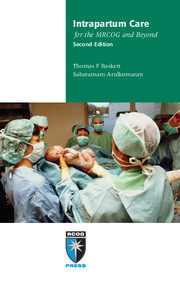Book contents
- Frontmatter
- Contents
- Preface
- Abbreviations
- 1 Improving intrapartum care
- 2 First stage of labour
- 3 Second stage of labour
- 4 Fetal surveillance in labour
- 5 Third stage of labour
- 6 Lower genital tract trauma
- 7 Induction of labour
- 8 Preterm labour and prelabour rupture of membranes
- 9 Assisted vaginal delivery
- 10 Shoulder dystocia
- 11 Breech vaginal delivery
- 12 Twin and triplet delivery
- 13 Caesarean section
- 14 Vaginal birth after caesarean section
- 15 Uterine rupture
- 16 Emergency obstetric hysterectomy
- 17 Cord prolapse
- 18 Antepartum haemorrhage
- 19 Postpartum haemorrhage
- 20 Acute uterine inversion
- 21 Amniotic fluid embolism
- 22 Disseminated intravascular coagulation
- 23 Acute tocolysis
- 24 Severe pre-eclampsia and eclampsia
- 25 Neonatal resuscitation
- 26 Perinatal loss: management of late fetal death and stillbirth
- Index
13 - Caesarean section
Published online by Cambridge University Press: 05 July 2014
- Frontmatter
- Contents
- Preface
- Abbreviations
- 1 Improving intrapartum care
- 2 First stage of labour
- 3 Second stage of labour
- 4 Fetal surveillance in labour
- 5 Third stage of labour
- 6 Lower genital tract trauma
- 7 Induction of labour
- 8 Preterm labour and prelabour rupture of membranes
- 9 Assisted vaginal delivery
- 10 Shoulder dystocia
- 11 Breech vaginal delivery
- 12 Twin and triplet delivery
- 13 Caesarean section
- 14 Vaginal birth after caesarean section
- 15 Uterine rupture
- 16 Emergency obstetric hysterectomy
- 17 Cord prolapse
- 18 Antepartum haemorrhage
- 19 Postpartum haemorrhage
- 20 Acute uterine inversion
- 21 Amniotic fluid embolism
- 22 Disseminated intravascular coagulation
- 23 Acute tocolysis
- 24 Severe pre-eclampsia and eclampsia
- 25 Neonatal resuscitation
- 26 Perinatal loss: management of late fetal death and stillbirth
- Index
Summary
Caesarean section has become the most common operation in women owing to the worldwide increase in caesarean delivery rates since the 1980s. A variety of factors have lowered the threshold for performing caesarean section:
• improvements in anaesthesia, blood transfusion, antibiotics, surgical techniques and thromboprophylaxis have combined to increase the safety of caesarean section
• a combination of social and medico-legal expectations of the perfect perinatal outcome
• less experience and an unwillingness to accept even small increased risks associated with certain types of operative vaginal delivery
• changing maternal demographics: increasing maternal age, obesity and reduced parity
• increasing maternal age, infertility and assisted reproductive techniques have led to a rise in the number of so-called ‘premium’ pregnancies as well as an increase in twin and triplet pregnancies
• improved neonatal care and outcomes have lowered the gestational age at which caesarean section is appropriate for fetal indications
• an uncommon but emerging indication is women requesting elective caesarean section for the perceived benefits of eliminating rare fetal risks in labour and the sequelae of pelvic floor damage to themselves.
Indications
While the indications and their proportion may vary from country to country and hospital to hospital, the big four indications account for 60–90% of all caesarean sections:
• repeat caesarean section (35–40%)
• dystocia (20–35%)
• breech (10–15%)
• fetal distress (10–15%).
- Type
- Chapter
- Information
- Intrapartum Care for the MRCOG and Beyond , pp. 155 - 168Publisher: Cambridge University PressPrint publication year: 2011



